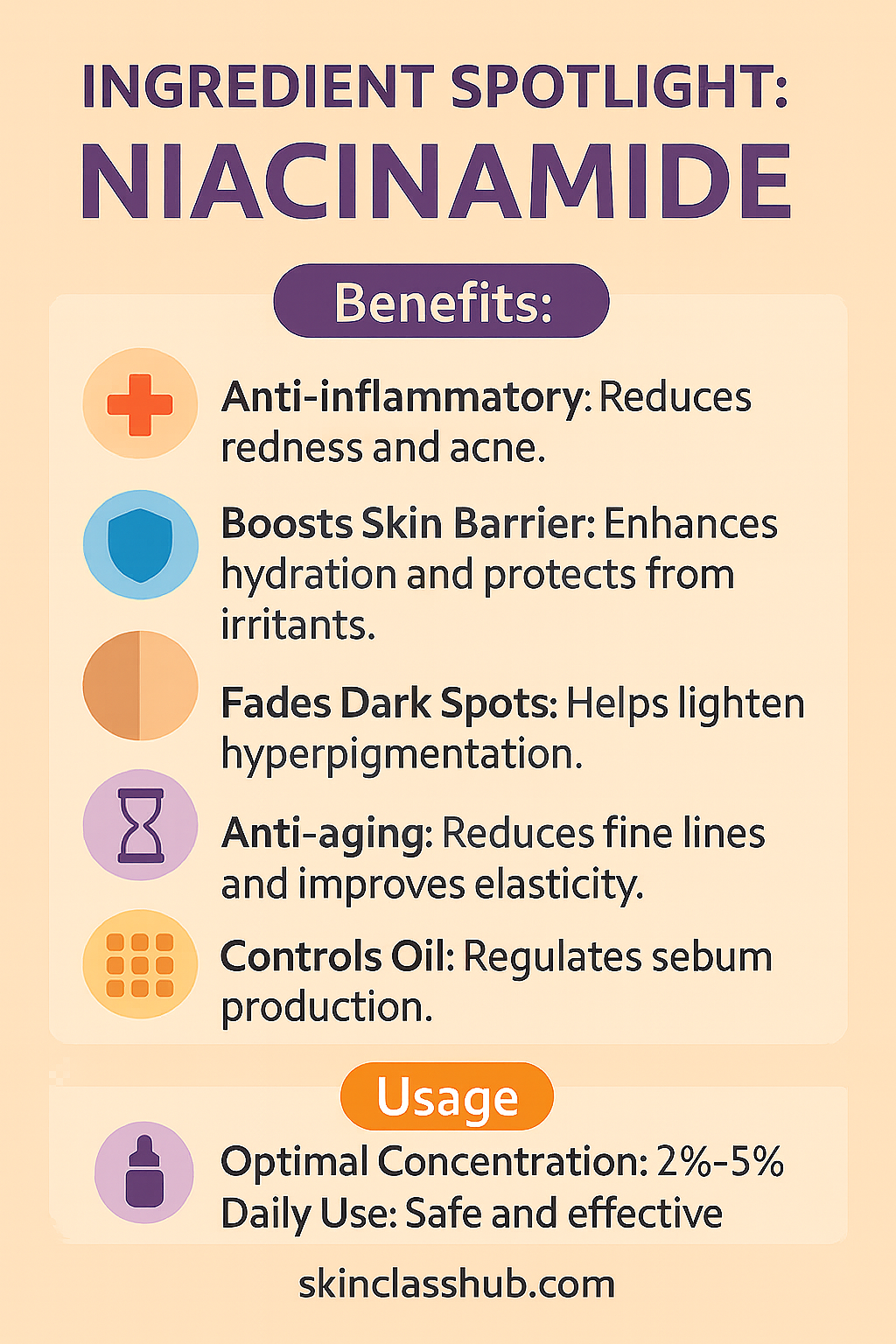Niacinamide

Summary: A versatile, well-tolerated ingredient with proven benefits for acne, pigmentation, skin barrier repair, and aging.
Published on: 30/03/2025
Niacinamide, also known as nicotinamide, is a water-soluble form of vitamin B3 (molecular formula: C₆H₆N₂O) that has become a popular skincare ingredient due to its versatility and proven efficacy. Numerous clinical studies support its beneficial effects, contributing to its rise in popularity in the past few years. It is interesting to note that despite the numerous documented benefits, niacinamide is officially listed only under the function "smoothing" in the EU's CosIng database. This limited categorization reflects regulatory classification rather than the comprehensive scientific evidence available.
Benefits of Niacinamide in Skincare
1. Anti-inflammatory and Acne Management
Niacinamide exhibits significant anti-inflammatory properties, which help reduce redness and irritation associated with acne and rosacea. Studies have shown that topical niacinamide can effectively decrease inflammatory lesions and sebum production, making it an excellent choice for acne-prone skin (1)(5)(8). One clinical trial even found it to be as effective as clindamycin in treating inflammatory acne (8).
2. Improving Skin Barrier Function
A healthy skin barrier prevents moisture loss and shields against irritants. Niacinamide enhances barrier function by stimulating the synthesis of ceramides and fatty acids, thus helping to reduce transepidermal water loss (TEWL) and improving skin hydration (2).
3. Reduction of Hyperpigmentation
Niacinamide can effectively lighten dark spots and hyperpigmentation by inhibiting melanosome transfer from melanocytes to keratinocytes. Clinical trials demonstrated significant improvements in hyperpigmentation after consistent topical application of niacinamide (3),(4),(7). In one study, niacinamide 4% showed comparable efficacy to hydroquinone 4% in treating melasma, with fewer side effects (7).
4. Anti-aging Effects
Niacinamide contributes to anti-aging by enhancing collagen production, reducing fine lines and wrinkles, and improving skin elasticity. One double-blind clinical trial found visible improvements in wrinkle reduction and skin elasticity after 12 weeks of niacinamide treatment (4).
5. Sebum Regulation
In addition to reducing inflammation, niacinamide regulates sebum production, beneficial for managing oily skin. A study demonstrated that applying 2% niacinamide significantly reduced sebum excretion rates after two weeks (1).
Optimal Concentrations and Usage
The optimal concentration of niacinamide for skincare ranges between 2% and 5%, with higher concentrations generally well-tolerated but occasionally causing mild irritation in sensitive skin. Daily use is safe and often recommended for ongoing skin improvement (6).
Potential Side Effects
Niacinamide is generally well-tolerated; however, in rare cases, high concentrations may cause redness or irritation. To minimize potential side effects, it is advisable to begin with lower concentrations and gradually increase if needed (6).
Pin it!

Conclusion
Niacinamide is a scientifically supported skincare ingredient offering multiple dermatological benefits, including anti-inflammatory, skin barrier enhancement, hyperpigmentation reduction, anti-aging effects, and sebum regulation. Its proven safety profile and broad-spectrum efficacy make it an excellent choice for inclusion in skincare routines targeting diverse skin concerns.
References
-
Draelos, Z. D., Matsubara, A., & Smiles, K. (2006). The effect of 2% niacinamide on facial sebum production. Journal of Cosmetic and Laser Therapy, 8(2), 96-101. The effect of 2% niacinamide on facial sebum production: Journal of Cosmetic and Laser Therapy: Vol 8 , No 2 - Get Access
-
Tanno, O., Ota, Y., Kitamura, N., Katsube, T., & Inoue, S. (2000). Nicotinamide increases biosynthesis of ceramides as well as other stratum corneum lipids to improve the epidermal permeability barrier. British Journal of Dermatology, 143(3), 524-531. https://academic.oup.com/bjd/article-abstract/143/3/524/6691624?redirectedFrom=fulltext
-
Hakozaki, T., Minwalla, L., Zhuang, J., et al. (2002). The effect of niacinamide on reducing cutaneous pigmentation and suppression of melanosome transfer. British Journal of Dermatology, 147(1), 20-31. https://doi.org/10.1046/j.1365-2133.2002.04834.x
-
Bissett, D. L., Miyamoto, K., Sun, P., Li, J., & Berge, C. A. (2004). Topical niacinamide reduces yellowing, wrinkling, red blotchiness, and hyperpigmented spots in aging facial skin. International Journal of Cosmetic Science, 26(5), 231-238. Topical niacinamide reduces yellowing, wrinkling, red blotchiness, and hyperpigmented spots in aging facial skin - PubMed
-
Walocko, F. M., et al. (2017). The role of nicotinamide in acne treatment. Dermatologic Therapy, 30(5), e12481. The role of nicotinamide in acne treatment - Walocko - 2017 - Dermatologic Therapy - Wiley Online Library
-
Rolfe, H. M. (2014). A review of nicotinamide: treatment of skin diseases and potential side effects. Journal of Cosmetic Dermatology, 13(4), 324–328. https://pubmed.ncbi.nlm.nih.gov/25399625
-
Navarrete-Solís, J., et al. (2011). A double-blind, randomized clinical trial of niacinamide 4% versus hydroquinone 4% in the treatment of melasma. Dermatology Research and Practice, 2011, 379173. A Double‐Blind, Randomized Clinical Trial of Niacinamide 4% versus Hydroquinone 4% in the Treatment of Melasma - Navarrete-Solís - 2011 - Dermatology Research and Practice - Wiley Online Library
-
Shalita, A. R., et al. (1995). Topical nicotinamide compared with clindamycin gel in the treatment of inflammatory acne vulgaris. International Journal of Dermatology, 34(6), 434-437. TOPICAL NICOTINAMIDE COMPARED WITH CLINDAMYCIN GEL IN THE TREATMENT OF INELAMMATORY ACNE VULGARIS - SHALITA - 1995 - International Journal of Dermatology - Wiley Online Library